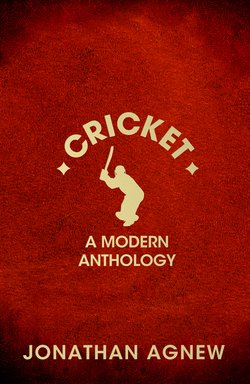Читать книгу Cricket: A Modern Anthology - Jonathan Agnew, Jonathan Agnew - Страница 15
Could Body-line be Mastered?
ОглавлениеI doubt if this question can be authoritatively answered.
It was used consistently for only one season against the same players, and nobody mastered it. A batsman who played defensively would certainly get caught by one of the short-leg fieldsmen. To try to hook the ball would result sooner or later in a catch on the boundary. Neither defence nor attack could overcome it for long, unless the batsman was particularly lucky.
Playing the good length balls and dodging the others may sound all right in theory, but it would not work in practice. The batsman doing this must of necessity be hit.
In fact no Australian batsman of any note failed to get hit, some on many occasions. Players naturally began to take the view that there were other sports offering many of the attractions of cricket without the risk of serious injury.
After his retirement from Test cricket, Hammond wrote about body-line, and I greatly admired his forthright condemnation thereof. Remember that Hammond was a member of the English Team which used it, and later became Captain of England. This is what he said:—
“I condemn it absolutely. Body-line is dangerous. I believe that only good luck was responsible for the fact that no one was killed by body-line. I have had to face it, and I would have got out of the game if it had been allowed to persist!
I doubt if there was any answer to such bowling unless grave risks of injury were courted.”
In that 1932–3 season I endeavoured to counter body-line by unorthodox methods which involved stepping away to cut the ball to the off, and in my view exposed me to a graver risk of injury than the orthodox type of batting. Whilst not completely successful, I did score over 50 runs in an innings 4 times in 4 Test Matches.
McCabe and Richardson both tried to counter it by orthodox methods. Both were very capable, game players and excellent hookers, yet each of them could only once exceed 50 in an innings in the same four matches. Our comparative figures in those four Tests were:—
In many quarters I was the subject of bitter adverse criticism for my methods. Jack Fingleton, a contemporary player, later wrote a book in which he cast very grave reflections on my tactics. It may be well to remind readers that his last 3 Test innings against Jardine’s men yielded 1, 0 and 0, whereupon he was dropped from the Australian team. In the same 3 innings I scored 177 runs at an average of 88.5. These figures scarcely give Fingleton any authority to criticise my methods. Apparently I had to make a century every time and also be hit more often than anyone else to satisfy the tastes of some. May I be pardoned for again quoting Constantine, a great batsman, and one of the fast bowlers who used body-line against England at Manchester. He says:—
“Of all batsmen in the world the last two to whom body-line should ever be bowled are Bradman and McCabe.”
Furthermore, he refers to Jardine making a century against it and says that to stand up and play defensive strokes at Lord’s or the Oval as he did at Old Trafford would have been quite impossible, and Jardine was over 6 feet in height. How much harder for those of short stature. It wasn’t only a question of whether it could be mastered, but rather that fellows would not bother to try—they would not consider it worth the candle.
Undoubtedly body-line was a reaction against the dominance of the bat over the ball, magnified by my own fortuitous 1930 season in England. But it was the wrong remedy. Killing a patient is not the way to cure his disease.
It was also a form of protest against the inadequacy of the L.B.W. law, because bowlers get very exasperated when they beat a batsman only to be deprived of his wicket by his pads.
Body-line certainly did some good in that it caused an alteration in the L.B.W. law (which M.C.C. agreed to at the time).
In my view the L.B.W. alteration, admirable though it was, did not go far enough. Long before the advent of body-line, I was in favour of an alteration to help bowlers. I openly advocated a change in 1933; I again made a strong appeal in an article I wrote in Wisden in 1938, and I am still agitating for a further change.
Recently I read an article where the writer was uncharitable enough to contend that my suggestion is related to my retirement. He obviously was poorly informed about my past expressions on the subject.
And there I want to end my references to body-line bowling. It was a passing phase, and I sincerely trust there will never be any need for umpires to contemplate taking action as they are empowered to do.
But I think it is desirable that the facts as detailed herein should be chronicled so that the matter shall be viewed in its proper perspective. The whole thing caused great misgivings and created much feeling. The best way for any reservations in the minds of the English public to be finally swept away is for them fully to understand and appreciate the real facts.
From Farewell to Cricket, 1950
